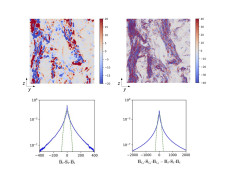New Conservation Laws in Turbulent Magnetized Flows

Using a novel multiscale analysis framework and massively parallel simulations, UofR researchers were able to disentangle the energy pathways in turbulent magnetized flows and find that there are two separated conservation laws instead of just one over an entire range of scales.
Science Achievement
University of Rochester researchers used a novel coarse-graining framework for disentangling multiscale interactions to discover two separate conservation laws over a large range of length scales in turbulent magnetized plasma flows. The work relied on a suite of massively parallel simulations run on NERSC using the DiNuSUR code developed at Rochester.
Impact
Flows that are coupled to magnetic fields – known as magnetohydrodynamic or MHD flows – are central to our understanding of a variety of systems ranging from the cosmological to the terrestrial. These include galaxies and clusters of galaxies, gas nebulae and the interstellar medium, star formation and evolution, solar wind and space weather, nuclear fusion, and metallurgy. In MHD flows, the total energy conserved, but not the magnetic and kinetic energies separately. Here, we find that that latter two are in fact conserved separately over a range of scales in turbulent flows. This yields two dynamical invariants (kinetic energy and magnetic energy) instead of just one (total energy). Invariants are highly prized quantities from which the governing laws of motion/evolution are derived. Our results have implications on the energetics and dissipation of these flows, the reconnection of magnetic field lines such as in solar flares, the amplification of magnetic field strength by dynamo action, and also on modeling efforts such as in accretion disks and active galactic nuclei.
Research Details
The work relied on a suite of massively parallel simulations to perform careful convergence studies and also to explore various the robustness of the results in systems under different physical conditions.
The simulations used up to 8.5 billion grid-points on 16,384 computing cores over a month’s worth of computing. They required about 6.3 million CPU-hours and generated over 6 Terabytes of data. NERSC staff helped student researchers troubleshoot I/O problems early on in the project.
Related Links
Bian, Xin; Aluie, Hussein, "Decoupled Cascades of Kinetic and Magnetic Energy in Magnetohydrodynamic Turbulence"; PHYSICAL REVIEW LETTERS, 122 2019 APR 5, 10.1103/PhysRevLett.122.135101
About NERSC and Berkeley Lab
The National Energy Research Scientific Computing Center (NERSC) is a U.S. Department of Energy Office of Science User Facility that serves as the primary high performance computing center for scientific research sponsored by the Office of Science. Located at Lawrence Berkeley National Laboratory, NERSC serves almost 10,000 scientists at national laboratories and universities researching a wide range of problems in climate, fusion energy, materials science, physics, chemistry, computational biology, and other disciplines. Berkeley Lab is a DOE national laboratory located in Berkeley, California. It conducts unclassified scientific research and is managed by the University of California for the U.S. Department of Energy. »Learn more about computing sciences at Berkeley Lab.







